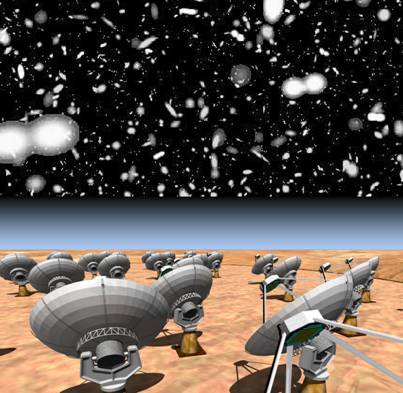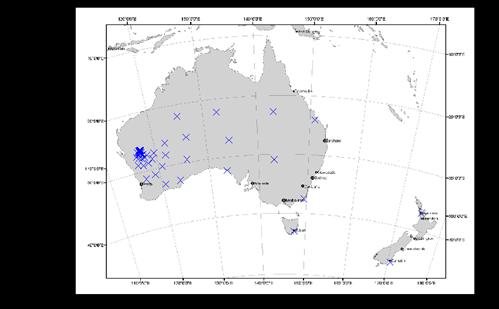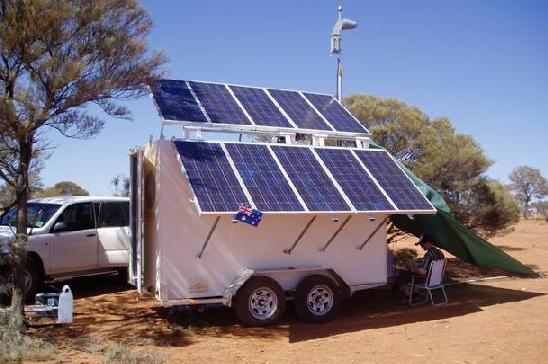SKA progress report
Progress is being made in many areas of SKA research and development within ATNF. Important milestones have been reached recently in the progress towards a New Technology Demonstrator telescope, and in the area of SKA siting studies. These two areas are highlighted below.
The SKA New Technology Demonstrator (NTD) project
Australian scientists and engineers have been continuing development of SKA technology concepts as funded by the Australian government through the Australian Astronomy Major New Research Facilities Program. After withdrawal, in 2004, of the Luneberg Lens concept as a candidate SKA design, ATNF has been continuing to work on the alternative SKA technology concepts that have been under development in Australia as part of the New Technology Demonstrator project of the MNRF program. The Australian SKA community decided, at the MNRF review point in 2004, that the NTD will be a technology demonstrator for wide field-of-view, low frequency, SKA solutions. The NTD project has now focused on the development of focal-plane array technology in association with parabolic reflectors for the antenna systems. The NTD team is being led by Dr Colin Jacka from the CSIRO ICT Centre and managed by Dr Tony Sweetnam, also from the CSIRO ICT Centre. The project has successfully completed a concept design review and is aiming towards a Critical Design Review point in December 2005. The technology objectives of the NTD are:
10 ×10 Focal Plane Array (FPA) operating over the frequency range 800 1700 MHz, with one to three parabolic reflector antennas;
Radio frequency interference (RFI) and spectral line ripple cancellation using FPA (commercial applications are possible);
RF and IF beam-forming to give extremely wide fields of view;
Polarisation purity;
Correlation of large number (at least 20) of independent beams;
Wide-band operation with low RFI levels; and
Proof of infrastructure in remote desert environment (power supply, on-site data transport).
 Figure 1: A visualisation of what the SKA could look like if constructed from the technology being considered for the New Technology Demonstrator project. Each parabolic dish is 15 metres in diameter. Image credit: Chris Fluke, Centre for Astrophysics and Supercomputing, Swinburne University of Technology, Australia, and Brian Boyle, CSIRO ATNF.
Figure 1: A visualisation of what the SKA could look like if constructed from the technology being considered for the New Technology Demonstrator project. Each parabolic dish is 15 metres in diameter. Image credit: Chris Fluke, Centre for Astrophysics and Supercomputing, Swinburne University of Technology, Australia, and Brian Boyle, CSIRO ATNF.
A plan has also been developed for an extended NTD telescope, which will be possible with additional funding to enable:
Modular upgrade path. Twenty parabolic reflectors equipped with 10 ×10 FPAs;
Correlation of a large number of antennas, and 20 independent beams being formed;
Real-time VLBI using high speed fibre-optic data links with other antennas forming long baselines on the continent of Australia;
Multiplexed VLBI exploiting wide field-of-view and multiple beams;
Special purpose signal processors (e.g. for pulsar searches) using phased array beams; and
Operational and processing software development.
As flagged at the previous AT Users Committee (ATUC) meeting, ATUC will organise an xNTD science workshop in Sydney in early April 2005. Further details will be available via the ATNF website and email before this time. Some of the scientific objectives of the xNTD project are:
An all-sky HI emission survey to z ~ 0.1;
A deep survey in HI to z ~ 0.3;
HI absorption to z ~ 0.7;
All-sky continuum surveys and monitoring of transient sources;
Mapping the Galactic HI with high brightness sensitivity;
Pulsar surveys;
Multiplexed VLBI on faint sources in deep imaging over wide field-of-view, with phase referenced calibration;
A large area survey for OH megamasers to z ~ 1; and
Probe galactic and extra-galactic magnetic fields.
A further purpose of the xNTD is to establish a significant presence at a remote low RFI site, highly suitable for the xNTD and other SKA pathfinder instruments.
Australian SKA siting activities

Figure 2: Diagram illustrating a possible configuration of array-stations for an SKA centred at Mileura Station. Each cross represents a cluster of antennas (an array-station) approximately 200 m in diameter. About half of all the array-stations lie within a 5-km diameter central region. There are 100 array-stations in total. Image credit: Steven Tingay, Swinburne University.
The Australian SKA Consortium Committee has selected a Western Australian site, centred on Mileura Station in the mid-west region of WA, as Australia's candidate SKA site.
The deadline for responses to the international Request for Proposals for SKA siting is 31 December 2005. Over the next year, information on the central site and the remote sites, as well as information on many other aspects of Australian SKA siting, will be collated and a proposal compiled.
Radio-frequency monitoring program
 Figure 3: The remotely operating radio-frequency monitoring set-up at Mileura Station Photo credit: Ron Beresford, CSIRO ATNF.
Figure 3: The remotely operating radio-frequency monitoring set-up at Mileura Station Photo credit: Ron Beresford, CSIRO ATNF. One requirement of the request for proposals is that site proponents conduct 12 months radio-frequency monitoring on the candidate site. The Australian SKA site bid has reached a significant milestone with the Australia Day deployment of the Radio Frequency Environment test kit at the remote Mileura Station, located 850 kms NW of Perth, WA.
The instrumentation includes a suite of calibrated antennas and low noise front-ends to characterise the potential radio interference levels from 50 MHz to 24 GHz at the prospective SKA core location in accordance with international SKA protocol.
A Rohde & Schwarz spectrum analyser driven by Labview software continually streams data in Microsoft SQL Database to large hard-drives. Particular attention was made to the reduction of self generated RFI and all digital equipment is housed in a screened enclosure.
The system is mobile, solar-powered and was designed and constructed for continuous 24/7 operation over the next year. A weather station has also been installed at the site. Curtin University (Perth) is already actively involved in field support and data reduction.
Radio-quiet Zone (RQZ)
A further requirement of the Request For Proposals is that site proponents indicate the strategy proposed for establishment of a radio-quiet zone for the SKA array-stations, to protect operation of the telescope from increase in man-made radio-frequency emissions. After a Government Forum held at Parliament House in August 2004, negotiations are continuing between ATNF, the Australian Communications Authority, and the Government of Western Australia to develop procedures for the implementation of a radio-quiet zone.
Michelle Storey and Ron Beresford
(Michelle.Storey@csiro.au, Ron.Beresford@csiro.au)
